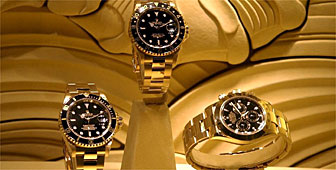Prestigious watch show brings glamour to Basel

Basel has begun to sparkle with the reflection of watches and jewellery as the world's top luxury goods show draws thousands of visitors.
The global market in luxury goods is currently worth an estimated $66 billion, with watches and jewellery sales representing 30 per cent of that (almost $20 billion).
Although consumer confidence weakened after the terror attacks in the United States last year, there is a mood of optimism that business in the sector is still very much alive.
Basel’s World Watch and Jewellery Show, which is this year celebrating its 30th anniversary, is the most important trade event of the year for many of the world’s leading prestige brands.
“It’s the most spectacular, the most exciting and the most important watch and jewellery event in the world,” enthuses general manager of Swiss Exhibitions, René Kamm.
All the big brands here
“With very few exceptions all the big brands are here. They spend up to SFr10 million francs for a stand just for one week and the way they exhibit their products is incredible. For somebody who’s never seen it, it’s unbelievable,” he told swissinfo.
The president of the exhibitors’ committee, Jacques Duchêne, said there was no doubt that the terror attacks of September 11 in the United States had weakened confidence in the luxury goods market.
“However, 2001 ended on a more favourable note with the Swiss watch market reporting sales up 3.7 per cent, with total global exports rising to SFr10.65 billion,” he added.
Duchêne commented that it was hard to predict what 2002 and 2003 would bring but forecasts were “optimistic”.
Kamm agreed, adding the current background was one of “challenging times”.
Lifestyle reappraisal
“The fourth quarter of 2001 was very bad for the industry and on a consumer level what we see is a reappraisal of lifestyle…on the other hand we see that especially the watch and jewellery sector is doing remarkably well despite that,” he told swissinfo.
“Already now we have strong signals that the markets are going up again,” he added.
Kamm commented that exhibitors in Basel had to have more realistic expectations this year than the previous two years, which had mirrored what happened on the markets globally.
More cautious
“It was a fantastic situation and they made big business at our show. This year the buyers will certainly be here but they will probably be a little more cautious in ordering,” he told swissinfo.
Despite the fact that there are five per cent fewer exhibitors than last year, the show is bigger than ever before, covering a record surface area of 95,157 square metres.
“We have quite definitely now reached our maximum capacity in Basel,” Kamm said.
To prove the point that Basel is bursting at the seams at this time of the year, once again ships on the River Rhine, which flows through the city, are once again being used as hotels for visitors to the fair.
Demand for more space from more exhibitors has continued unabated with the diversification of fashion brands into watches and jewellery and watch makers adding jewellery to their collections.
Appeal to the emotions
The luxury goods sector first and foremost appeals to the emotions. That means, for example, that a watch does not just simply tell the time. It says much about the person who bought it or the buyer hopes that.
“It’s all about emotion because you can have the pure functionality of seeing what time it is for SFr10,” Kamm said.
“But of course there must be a real value behind it. That’s the reason why you see the prestige brands becoming more and more important. It’s not because they have nice advertising or they are clever in communication but because they have a product that fulfils expectations and they have a craftsmanship behind it and something that has a long-term value,” he added.
As part of the fair, the organisers will be holding a forum on Tuesday next week to discuss the challenges facing the luxury goods’ industry.
Consumers more demanding
The premise is that consumers, while embracing trusted brands, are more demanding in the way they build relationships with them.
Exploring some of the drivers of innovation in the industry will be three eminent speakers – Tyler Brûlé who is helping to give Switzerland’s new airline “swiss” a brand image, John Naisbitt, the award-winning, best selling author of Megatrends and Professor Michael Hawley from MIT’s Media Lab.
Those who simply want to see what is on offer will be spoiled for choice. Many of the traditional Swiss names in the watchmaking industry tend to be answering a market demand for mechanical watches featuring a device which compensates for the effects of gravity – the tourbillon.
At the other end of the scale, one of the worldwide launches at Basel comes from the US company Timex. It is a watch which brings sophisticated space science down to earth and on to the wrist.
The Ironman Speed and Distance System answers a basic question. How far and how fast have I gone today? The Timex multi-sport watch using GPS (Global Positioning System) can answer that.
In the research laboratories of the world’s leading brands, engineers are working on a host of other applications for timepieces.
Will the watch of the future be able to turn up the heating in your house or take your temperature? Does the consumer really want that? These are issues that the engineers and the technology innovators are looking at now.
The Basel Fair ends on April 11.
by Robert Brookes

In compliance with the JTI standards
More: SWI swissinfo.ch certified by the Journalism Trust Initiative
You can find an overview of ongoing debates with our journalists here. Please join us!
If you want to start a conversation about a topic raised in this article or want to report factual errors, email us at english@swissinfo.ch.